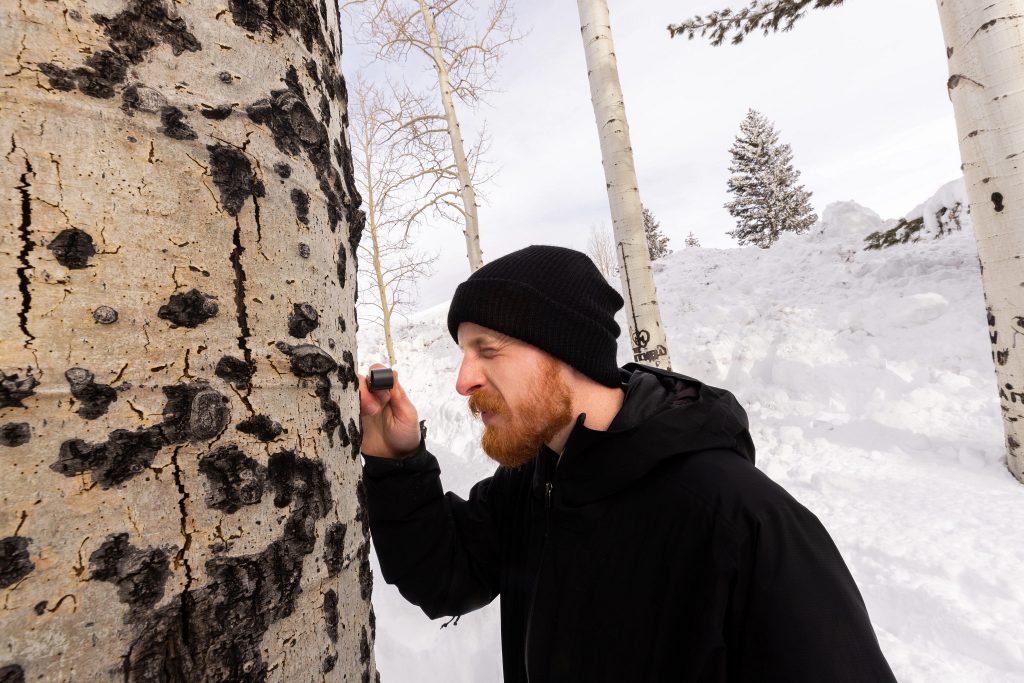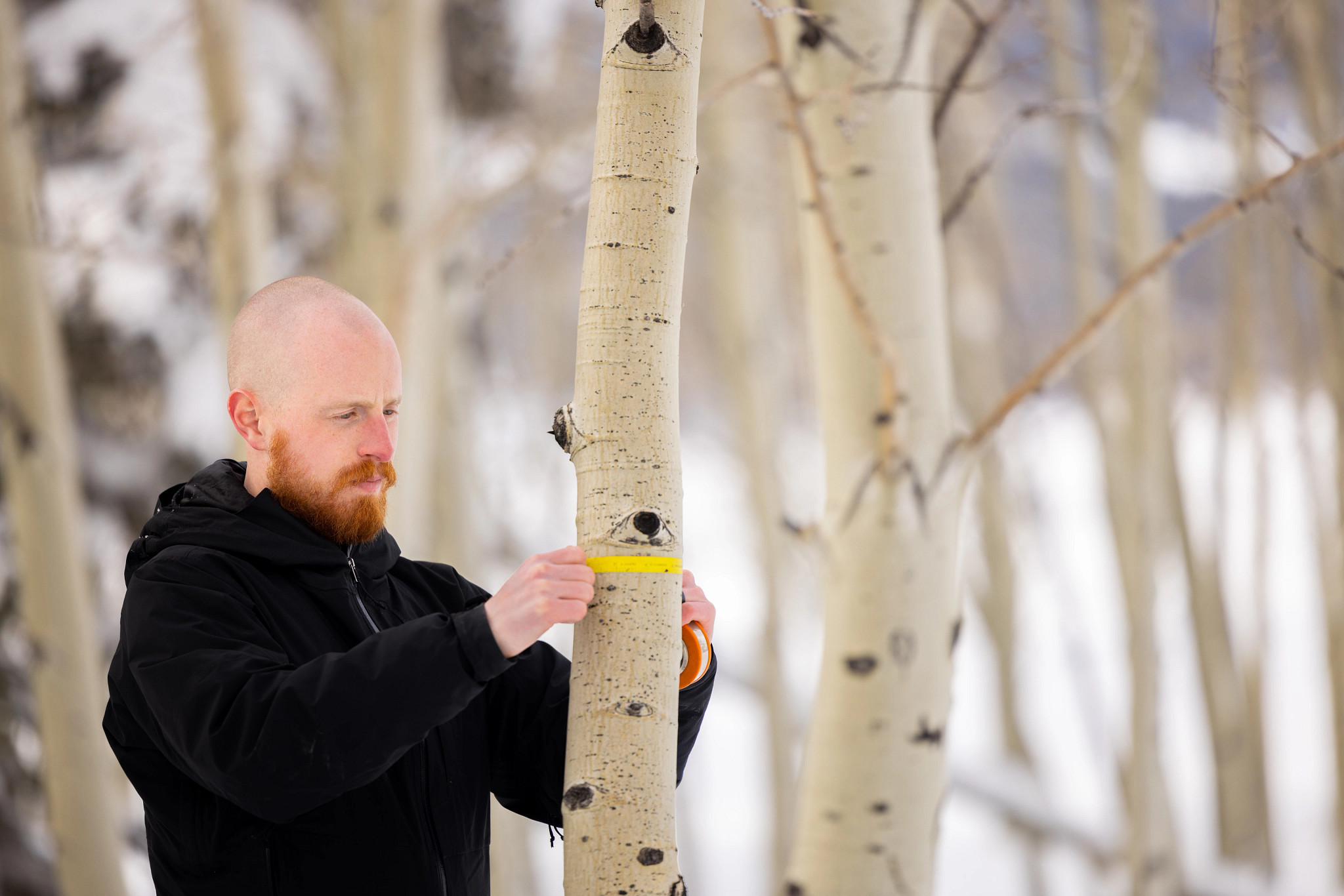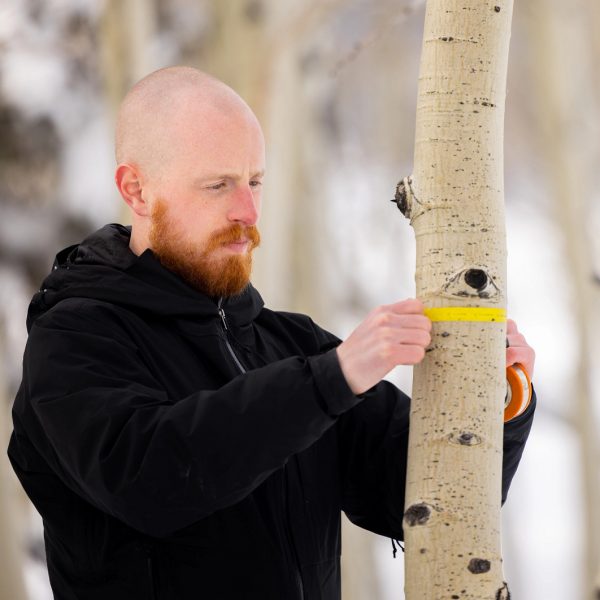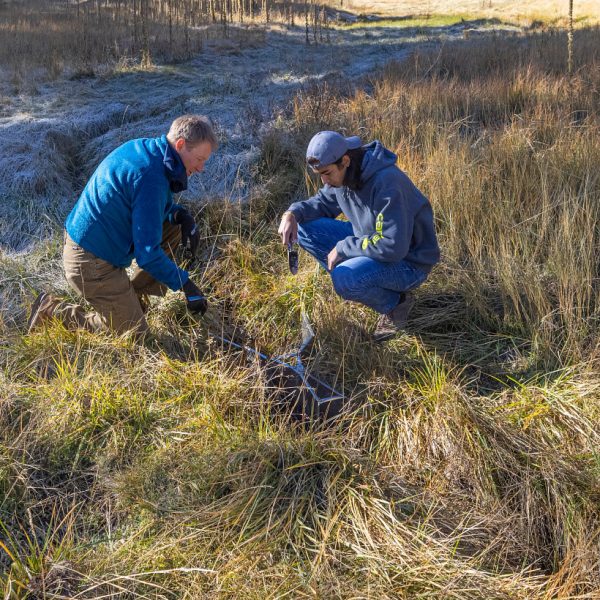Aspen trees are in danger.
As they try to grow, young trees get hit left and right by stressors, including oystershell scale (OSS) insect infestation, climate change, and destruction of new growth due to elk and deer browsing. While the public might despair and wonder if anything can be done, Forest Science PhD candidate Connor Crouch rubs his hands together and starts looking for solutions. “It’s an engaging challenge to figure out what we can do to keep aspen on the landscape,” he says. “Forest managers and the public want to maintain healthy aspen ecosystems. So, we’re not going to throw up our hands and say, ‘Well, we’ll see what happens.’ Instead, we ask, ‘What can we do to solve this problem?’”
As a journalism undergrad at the University of Missouri, Crouch was on a backpacking trip in the Smoky Mountains when he came across broad swaths of trees that had died from diseases and invasive insects. It was an eye-opening experience that set him on a new career trajectory. He ended up taking some forestry classes during his undergraduate program, relating that “ever since that first experience and some of those early classes I took, I’ve been interested in insects and diseases that impact forest health.” He received a master’s degree in forestry from the University of Missouri and is now working on his PhD in NAU’s School of Forestry, studying OSS and aspen trees with Kristen Waring, Professor of Applied Forest Health and Silviculture (forest conservation and management). In addition to Crouch and Waring, the research team includes Richard Hofstetter, Professor of Entomology (study of insects) as well as Nick Wilhelmi and NAU alum Amanda Grady, both of whom work for the Forest Service’s Forest Health Protection office in Flagstaff.
Studying insect infestations
OSS is an invasive sap-sucking insect introduced to North America in the 1700s and now affects tree species across the continent. As Crouch explains, “The vast majority of non-native insect species are pretty innocuous. But there’s a subset of them that cause serious harm to native ecosystems. And that’s where the term invasive comes in.” He is studying the impacts of OSS infestations on aspen in the Southwest and offering treatment recommendations to local forest managers.

While scientists first documented OSS on aspen trees a few decades ago, it wasn’t until the last five or six years that they started seeing negative impacts from the insect infestation. “We think climate is probably what triggered the outbreaks that we’re seeing now. Either warmer temperatures help the insect survive and reproduce, or the warmer temperatures are stressing the aspen out because we know aspens are susceptible to environmental stress,” Crouch says. “Those warmer temperatures might weaken its defenses and allow oystershell scale to go gangbusters.”
Crouch also pointed out another interesting discovery from their research: OSS seems to be unable to handle very cold temperatures. “Right around Flagstaff, there is tons of OSS, but if you go up on the Peaks, you won’t see any,” he says.
Young aspen trees, with small stems, appear especially prone to OSS. Crouch calls these trees “the aspen forests of the future.” Elk and deer browsing, climate change, fire suppression, and OSS are all bottlenecks limiting the abundance of young aspen on the landscape.
Part of Crouch’s study is trying to find strategies that mitigate OSS and the other stressors on the aspen. “That’s what I’m interested in. We have all these stressors on forest ecosystems and trying to understand the impacts that those are having. And then, what can managers do to try and keep these important ecosystems on the landscape.”
Collaborating to solve problems
While at NAU, Crouch has been enjoying the outdoors and the collaborative nature of the School of Forestry. “I’m working with an entomologist, a silviculturist; I’m talking with people who do hydrology and soils,” he says. “And we’re working together to figure out these big, important problems. That’s something that makes NAU’s School of Forestry really cool. I’ve grown a lot from experiencing that.”
He also appreciates the partnerships between NAU and the national forests and thanks his mentor, Professor Waring, for introducing him to local partners. “She’s the reason that I came here. She is the one I’ve relied on for all these connections with folks working on the forest here.”
His goal after he finishes his PhD is to continue research, possibly with the US Forest Service. He is passionate about problem solving and continuing to work with forest managers. “We have these problems on the forest—many human-caused—but I want to continue trying to figure out what forest managers can do to promote and maintain ecosystems that we really care about.”
In 2021 and 2022, Crouch received ARCS Scholar awards, which recognized his excellence in research and helped fund his field work. For more on Crouch and his team’s efforts to save aspen trees, head to The NAU Review.








